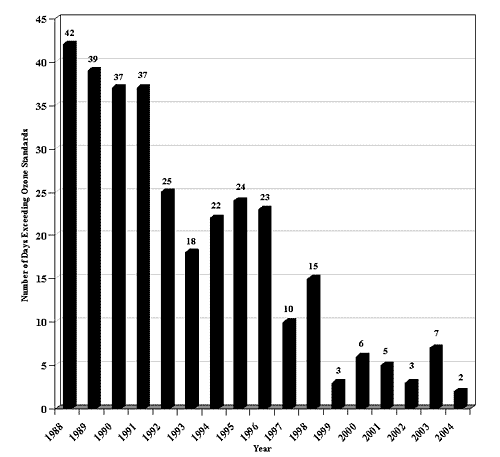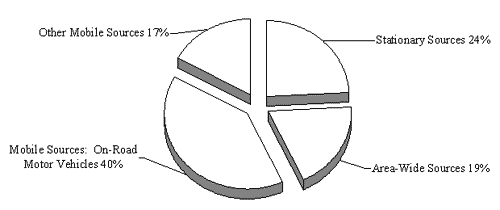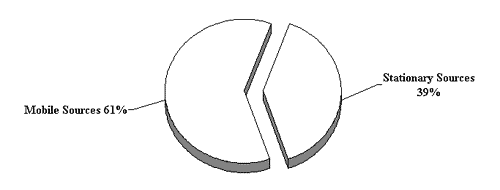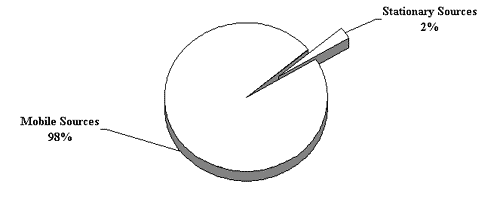- Go to 2004 Clean Air Plan description and Table of Contents
- Download Complete Final 2004 Clean Air Plan (5MB).
- Download Final Supplemental Environmental Impact Report (SEIR)
- Introduction
- Why is this 2004 Plan being prepared?
- What is new in this 2004 Plan revision?
- How was this 2004 Plan revision prepared?
- What are the health effects of ozone?
- Is air quality improving?
- How is attainment of the state 1-hour ozone standard determined?
- Does this 2004 Plan address any federal requirements?
- What are the key state requirements that this 2004 Plan addresses?
- How has the emission inventory changed?
- Where does our human-generated air pollution come from?
- Has the overall control strategy changed?
- Does the 2004 Plan show that we will attain the state 1-hour ozone standard?
- How does the adoption of this 2004 Plan impact rulemaking at APCD?
INTRODUCTION
Air quality in Santa Barbara County continues to improve and 2004 was one of the cleanest years on record. In fact, our air quality has improved to the point that the United States Environmental Protection Agency (USEPA) has declared us an attainment area for the federal 1-hour ozone standard. Meeting this milestone is clear evidence that Santa Barbara County residents are breathing cleaner air. However, we do not yet comply with the state 1-hour ozone standard which is more protective of public health. Therefore, this 2004 Clean Air Plan (2004 Plan) will focus solely on the state 1-hour ozone standard and the associated planning requirements mandated by the 1988 California Clean Air Act.
Continuing our progress toward clean air is a challenge that demands participation by the entire community. A Clean Air Plan represents the blueprint for air quality improvement in Santa Barbara County; the goals are to explain the complex interactions between emissions and air quality, and to design the best possible emission control strategy in a cost-effective manner. This 2004 Plan represents a partnership among the Air Pollution Control District (APCD), the Santa Barbara County Association of Governments (SBCAG), the California Air Resources Board (ARB), the USEPA, local businesses, and the community at large to reduce pollution from all sources: cars, trucks, industry, consumer products, and many more.
We have made remarkable progress in cleaning our air; the number of unhealthful air quality days in Santa Barbara County has been reduced by more than 95 percent from 1988 to 2004 despite substantial increases in population and vehicle miles traveled. The community should be proud of these accomplishments in reducing air pollution. This 2004 Plan reflects a commitment to continue this progress and bring clean air to all of the residents of Santa Barbara County.
WHY IS THIS 2004 PLAN BEING PREPARED?
This 2004 Plan is being prepared to address California Clean Air Act mandates under Health and Safety Code sections 40924 and 40925 that require that every three years areas update their clean air plans to attain the state 1-hour ozone standard. More specifically, this 2004 Plan provides a three-year update to the APCD’s 2001 Clean Air Plan. Previous plans developed to comply with the state ozone standard include the1991 Air Quality Attainment Plan, the 1994 Clean Air Plan, and the 1998 Clean Air Plan.
WHAT IS NEW IN THIS 2004 PLAN REVISION?
Each clean air plan revision represents a snapshot in time, based on the most current information available. This 2004 Plan is similar to the 2001 Clean Air Plan but includes significant new information. Some key new elements are:
- Updated local air quality information (through 2004)
- An updated emission inventory (year 2000)
- An updated emission estimate of marine shipping emissions (year 2000)
- Updated future year emission estimates through 2020 – Identification of every feasible emission control measure as part of the overall emission control strategy
HOW WAS THIS 2004 PLAN REVISION PREPARED?
APCD prepared this 2004 Plan in partnership with SBCAG, ARB, and USEPA. SBCAG provided future growth projections, developed the transportation control measures, and estimated the on-road mobile source emissions. ARB provided information on statewide mobile sources and consumer product control measures. USEPA provided information on the status of the control efforts for federally regulated sources.
To help provide important local policy and technical input on APCD clean air plans and rules, the APCD Board of Directors established the Community Advisory Council. Starting in January of 2004, the CAC considered various components of this 2004 Plan at their monthly meetings. The input provided by the Community Advisory Council was, on many occasions, directly incorporated into this 2004 Plan. APCD staff also conducted public workshops to obtain direct public input on the 2004 Plan.
WHAT ARE THE HEALTH EFFECTS OF OZONE?
Ozone can damage the respiratory system, causing inflammation, irritation, and symptoms such as coughing and wheezing, and worsening of asthma symptoms. High levels of ozone are especially harmful for children, people who exercise outdoors, older people, and people with asthma or other respiratory problems. Ozone can harm the development of children’s lungs, and recent studies suggest ozone plays a role in causing early childhood asthma. Ozone air pollution also hurts the economy by increasing hospital visits and medical expenses, and loss of work time due to illness, and by damaging crops, buildings, paint, and rubber.
IS AIR QUALITY IMPROVING?
Figure EX-1 presents the number of state ozone exceedances in Santa Barbara County during the period of 1988 to 2004. The most striking feature of Figure EX-1 is the dramatic decrease in the number of state ozone exceedances since 1988, when the when the state standard was exceeded on 42 days. In contrast, the state ozone standard was exceeded on only 2 days during 2004. A clear declining trend in the number of state ozone exceedances is evident from 1988 through 1999. Since 1999 however, with a relatively low number of exceedances experienced in the county, the trend is less discernable.
Figure EX-1 Number of Days Exceeding the State 1-Hour Ozone Standard Santa Barbara County 1988-2004*

*2004 Data are preliminary
HOW IS ATTAINMENT OF THE STATE 1-HOUR OZONE STANDARD DETERMINED?
Attainment of the state 1-hour ozone standard is determined using a statistical model developed by the ARB that excludes extreme concentration events, which are not expected to occur more frequently than once per year. This statistical concentration is commonly referred to as the Expected Peak Day Concentration (EPDC). An area is considered to be in attainment of the state 1-hour ozone standard if all monitoring stations have ozone concentrations less than 0.09 ppm, after excluding those days with concentrations identified as extreme events.
DOES THIS 2004 PLAN ADDRESS ANY FEDERAL REQUIREMENTS?
This 2004 Plan does not address any specific federal planning requirements, as Santa Barbara County was designated as an attainment area for the federal 1-hour ozone standard in 2003. All of Santa Barbara County’s federal requirements are documented in the 2001 Clean Air Plan. The USPEA has also designated the county as an attainment area for the federal 8-hour ozone standard, although we only meet the attainment test by a very slim margin. A Clean Air Plan to implement the new federal 8-hour standard is due by June 15, 2007, under USEPA’s Final Implementation Rule (69 FR 23951).
WHAT ARE THE KEY STATE REQUIREMENTS THAT THIS 2004 PLAN ADDRESSES?
The key requirements of the California Clean Air Act addressed in this 2004 Plan are the Triennial Progress Report (H&SC Section 40924(b)) and the Triennial Plan Revision (H&SC Section 40925(a)). Additionally, this 2004 Plan must provide an annual five percent emission reduction of ozone precursors, or, if this cannot be done, include every feasible measure as part of the emission control strategy. Finally, state law requires this 2004 Plan to provide for attainment of the state ambient air quality standards at the earliest practicable date (H&SC Section 40910).
HOW HAS THE EMISSION INVENTORY CHANGED?
An updated emission inventory was developed for 2000 for both onshore and Outer Continental Shelf (OCS) sources for this 2004 Plan. This inventory serves as our base year emission inventory, and is used to forecast emissions for 2005, 2010, 2015, and 2020. The 2000 emission inventory was developed in accordance with ARB and USEPA policies and procedures. The emissions inventory follows the organizational structure developed by ARB, and assigns all air pollution sources into one of four categories: stationary sources, area-wide sources, mobile sources, and natural sources. The biggest change to the emission inventory since the 2001 Plan is to marine shipping emissions which are significantly higher than previously estimated.
WHERE DOES OUR HUMAN-GENERATED AIR POLLUTION COME FROM?
Figure EX-2 shows Santa Barbara County’s Planning emission inventory for 2000. This figure presents the estimated emissions of reactive organic compounds and oxides of nitrogen (precursors that combine to form ozone), generated locally by human activities. This does not include emissions on the Outer Continental Shelf, or those from natural sources (seeps and vegetation). The largest contributor to our locally generated air pollution is on-road mobile sources (cars and trucks), which contribute 40 percent of the reactive organic compounds and 55 percent of the emissions of oxides of nitrogen. Other mobile sources (planes, trains, boats), the evaporation of solvents, combustion of fossil fuels, surface cleaning and coating, and petroleum production and marketing combine to make up the remainder. Figure EX-3 shows the emission inventory for the Outer Continental Shelf, where the majority of reactive organic compounds (61 percent) and oxides of nitrogen (98 percent) emissions comes from mobile sources (predominantly international marine shipping activities).
Figure EX-2 2000 Santa Barbara County Planning Emission Inventory
ROC 41.84 tons per day
NOx 43.89 tons per day
Figure EX-3 2000 OCS Planning Emission Inventory
ROC 2.91 tons per day
NOx 33.37 tons per day
HAS THE OVERALL CONTROL STRATEGY CHANGED?
The overall strategy for control of both reactive organic compounds and oxides of nitrogen adopted in the 2001 Clean Air Plan continues in this 2004 Plan, with the addition of eight new or revised stationary source control measures, and updated transportation control measures. The 2001 Clean Air Plan contained: (1) the control measures needed to maintain the federal 1-hour ozone standard, (2) additional control measures needed to address state requirements and attain the state 1-hour ozone standard, and (3) measures that merit further study, referred to here as further study measures. This 2004 Plan evaluates each of the further study measures identified in the 2001 Clean Air Plan and sets a schedule for adoption of those measures that were determined to be feasible. This 2004 Plan also identifies further study measures that will be reviewed and evaluated in the next plan revision and update process.
DOES THE 2004 PLAN SHOW THAT WE WILL ATTAIN THE STATE 1-HOUR OZONE STANDARD?
This 2004 Plan shows that onshore emissions of reactive organic compounds and oxides of nitrogen will continue to decrease through 2020, due primarily to on-road mobile source emission reduction measures. However, the large emission increases expected to occur in the OCS due to marine shipping activities are dramatic. While these offshore emissions may not have the same direct impact on our air as onshore emissions, their magnitude may impair our ability to attain the state 1-hour ozone standard. This 2004 Plan does not contain detailed photochemical modeling that would be required to demonstrate attainment for the state 1-hour ozone standard.
HOW DOES THE ADOPTION OF THIS 2004 PLAN IMPACT RULEMAKING AT THE APCD?
The rules that are proposed in this 2004 Plan are directly included into the rulemaking priorities of the APCD. The measures that this Plan proposes on a near-, mid-, or long-term basis will be adopted by the APCD according to that schedule. The formal adoption of this 2004 Plan by the APCD Board of Directors establishes the commitments to adopt all proposed rules according to the schedule identified in the plan.
- Return to 2004 Clean Air Plan description and Table of Contents
- Download Complete Final 2004 Clean Air Plan (5MB).
- Download Final Supplemental Environmental Impact Report (SEIR)

